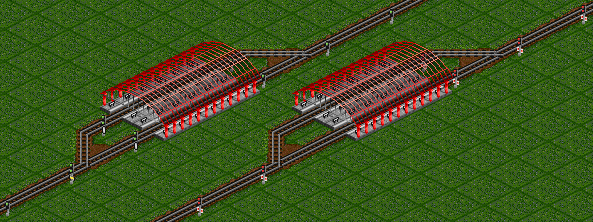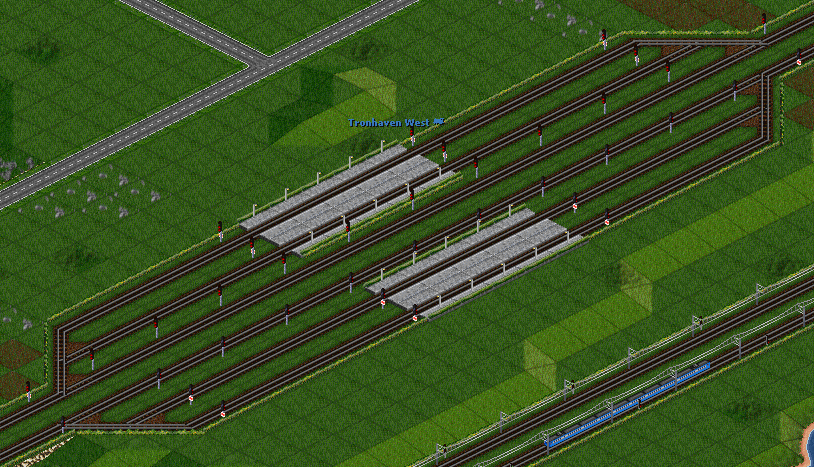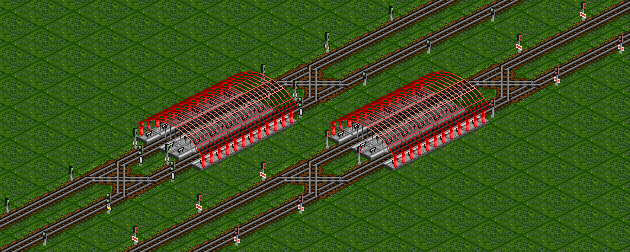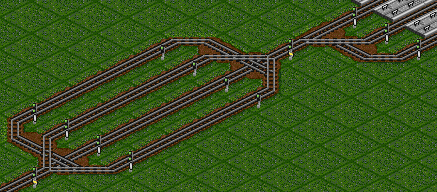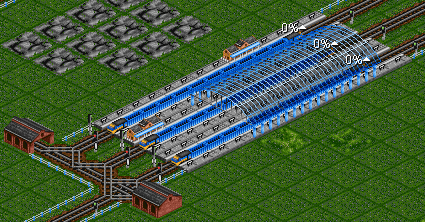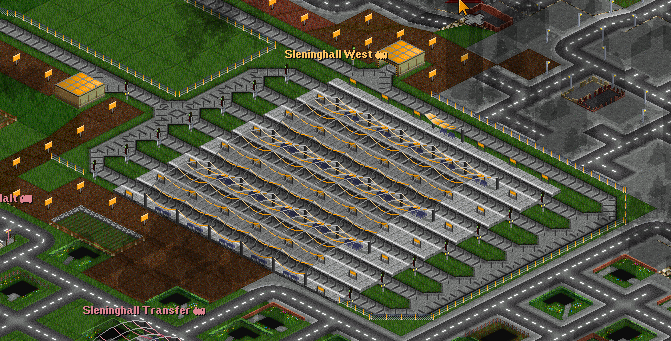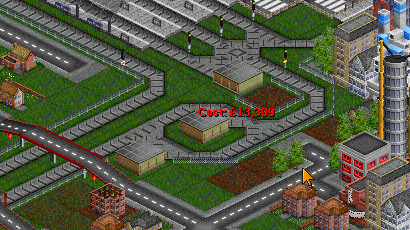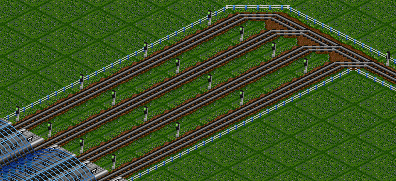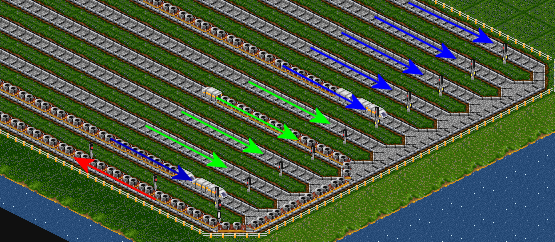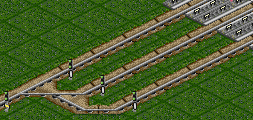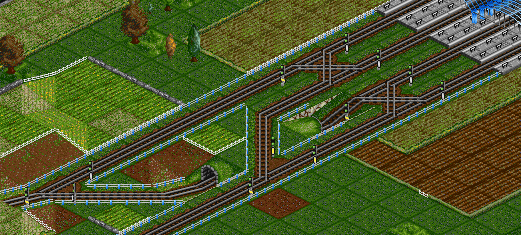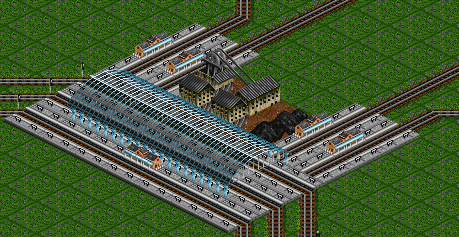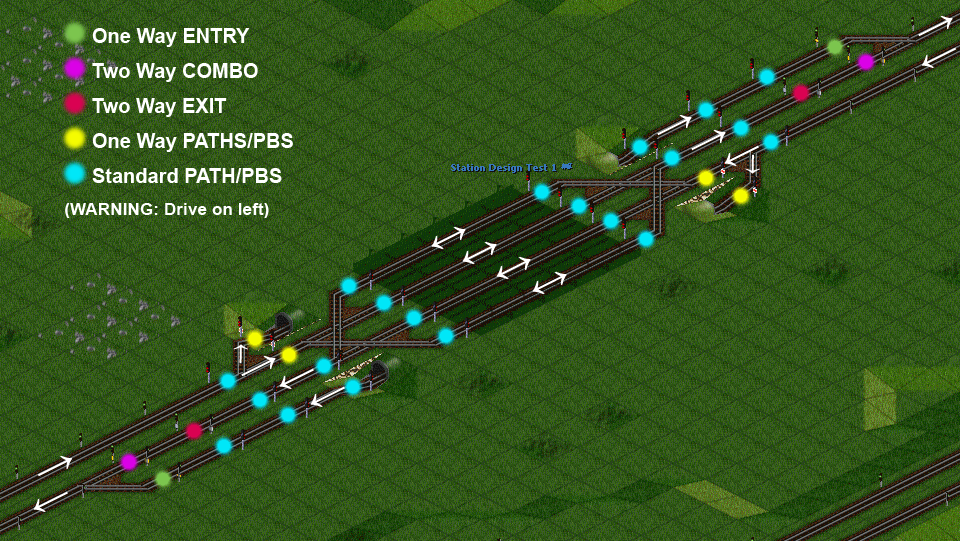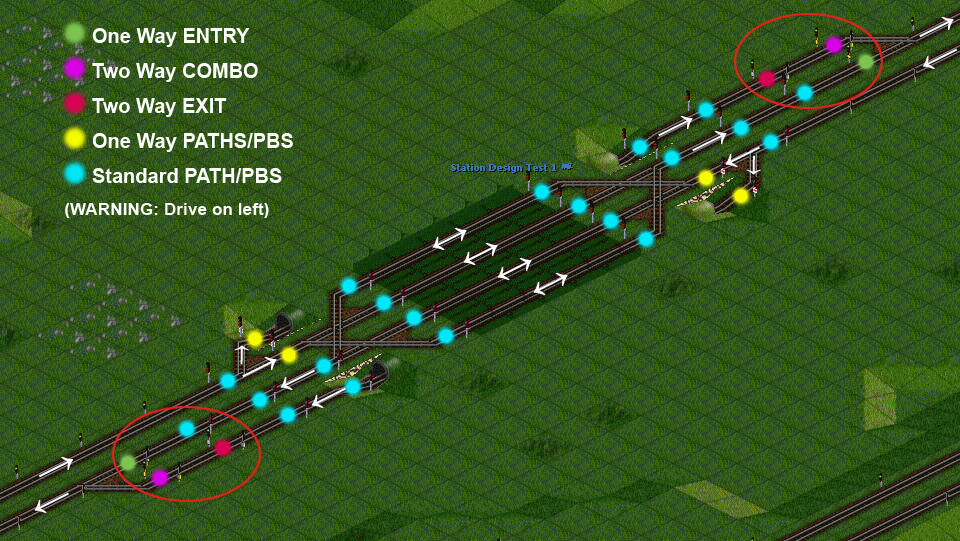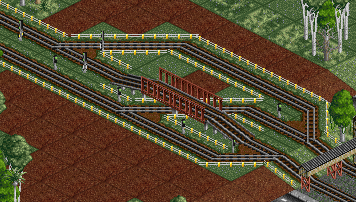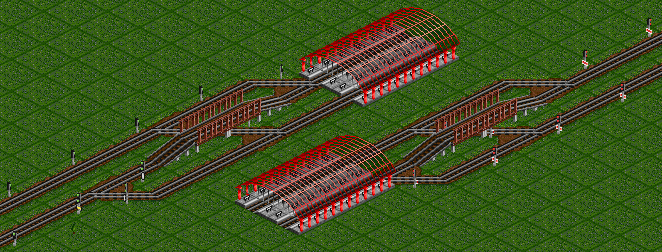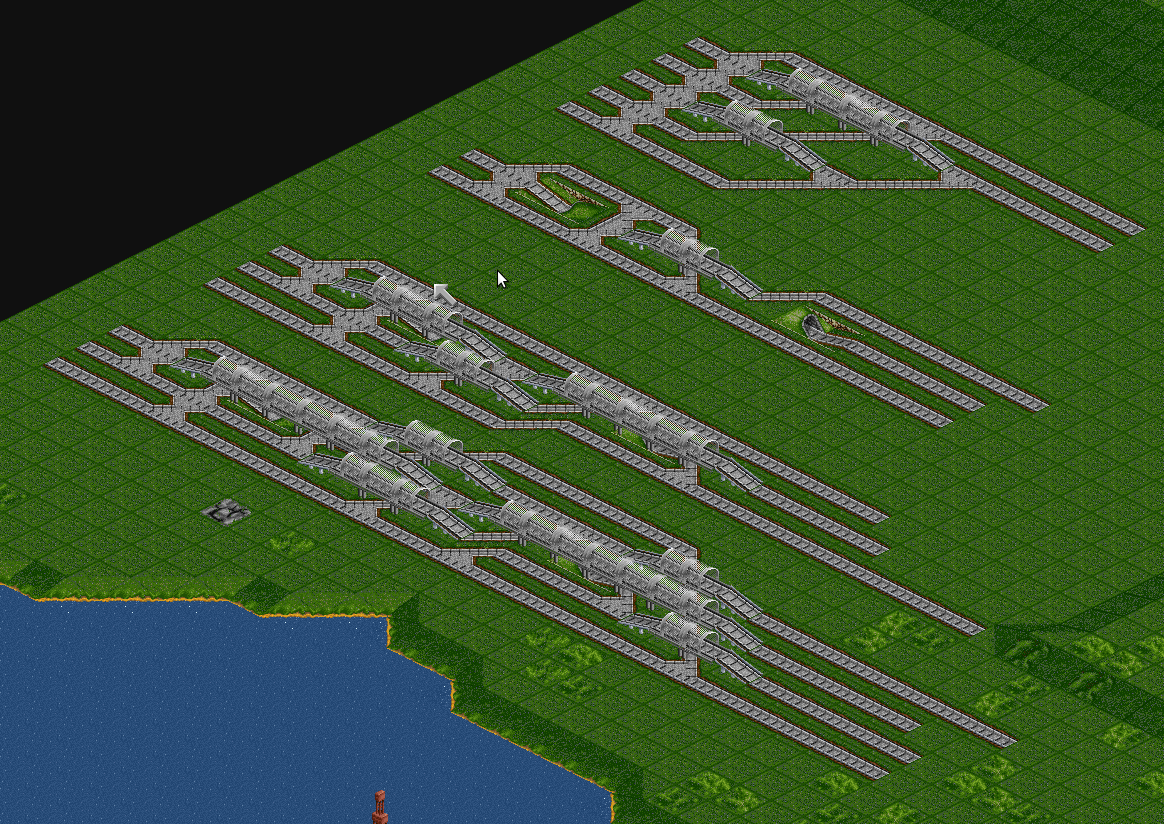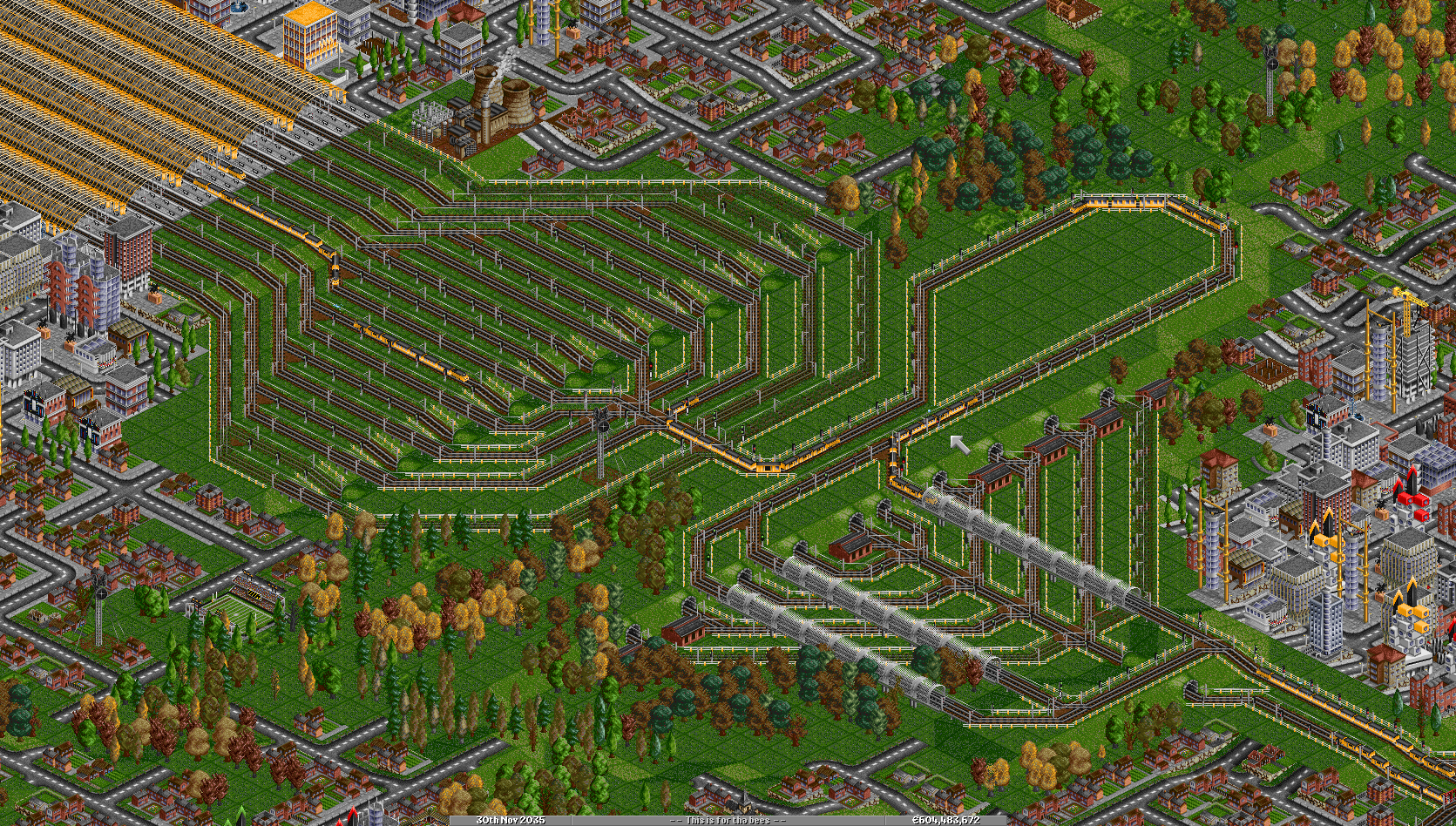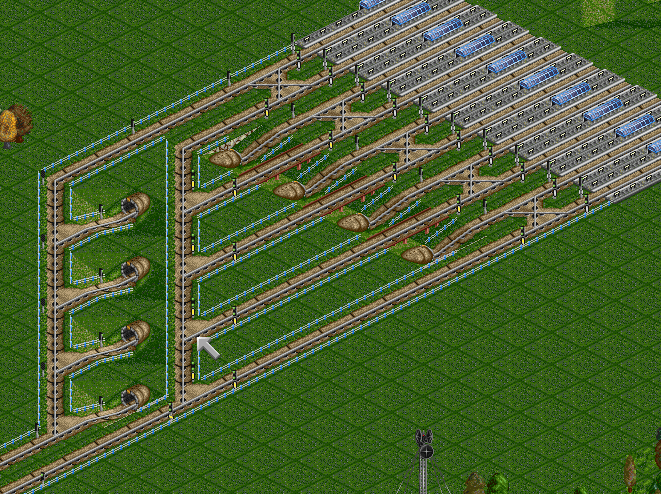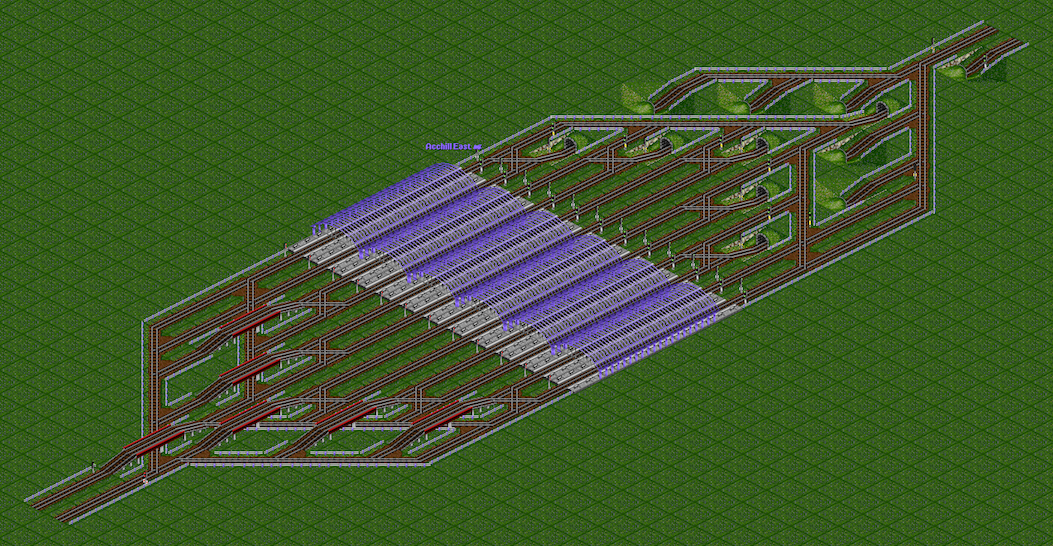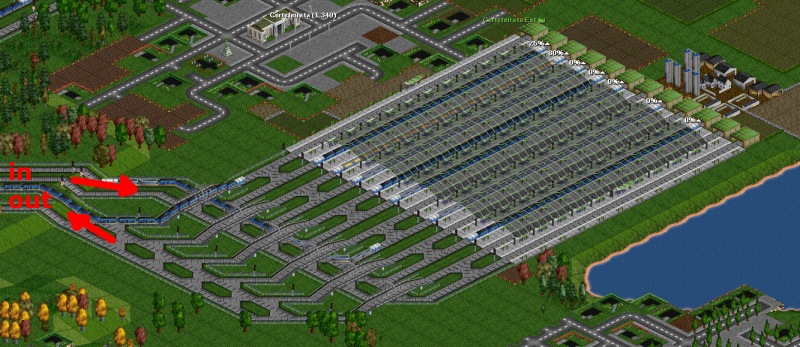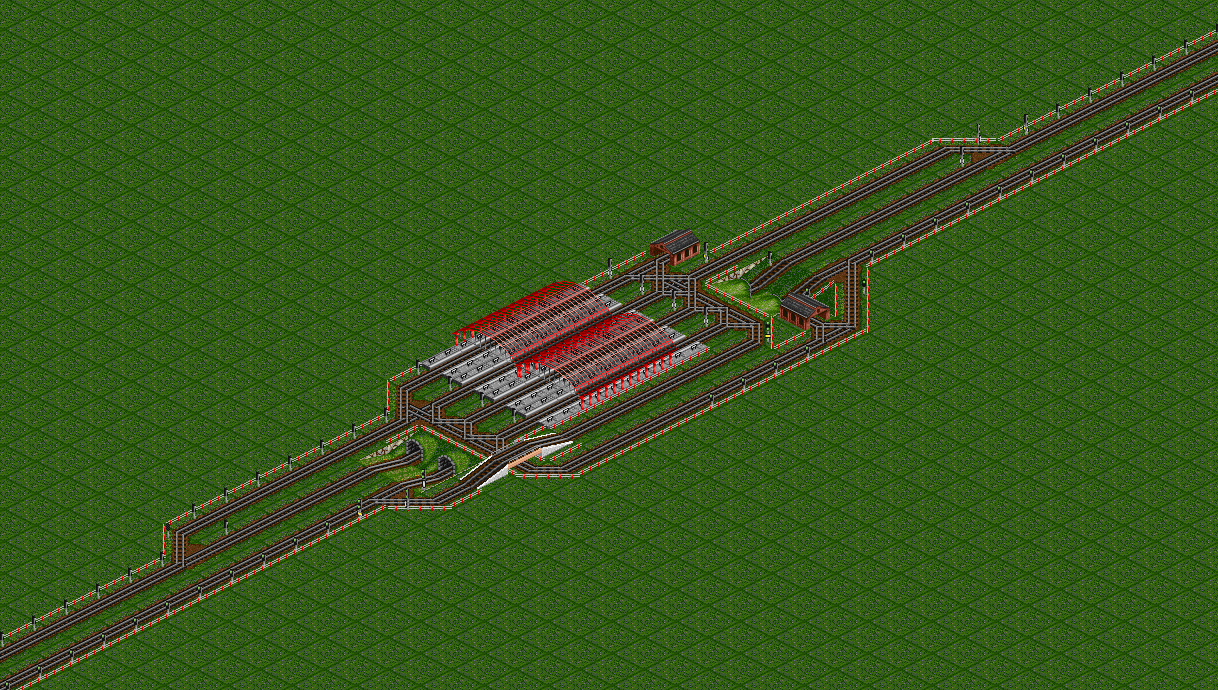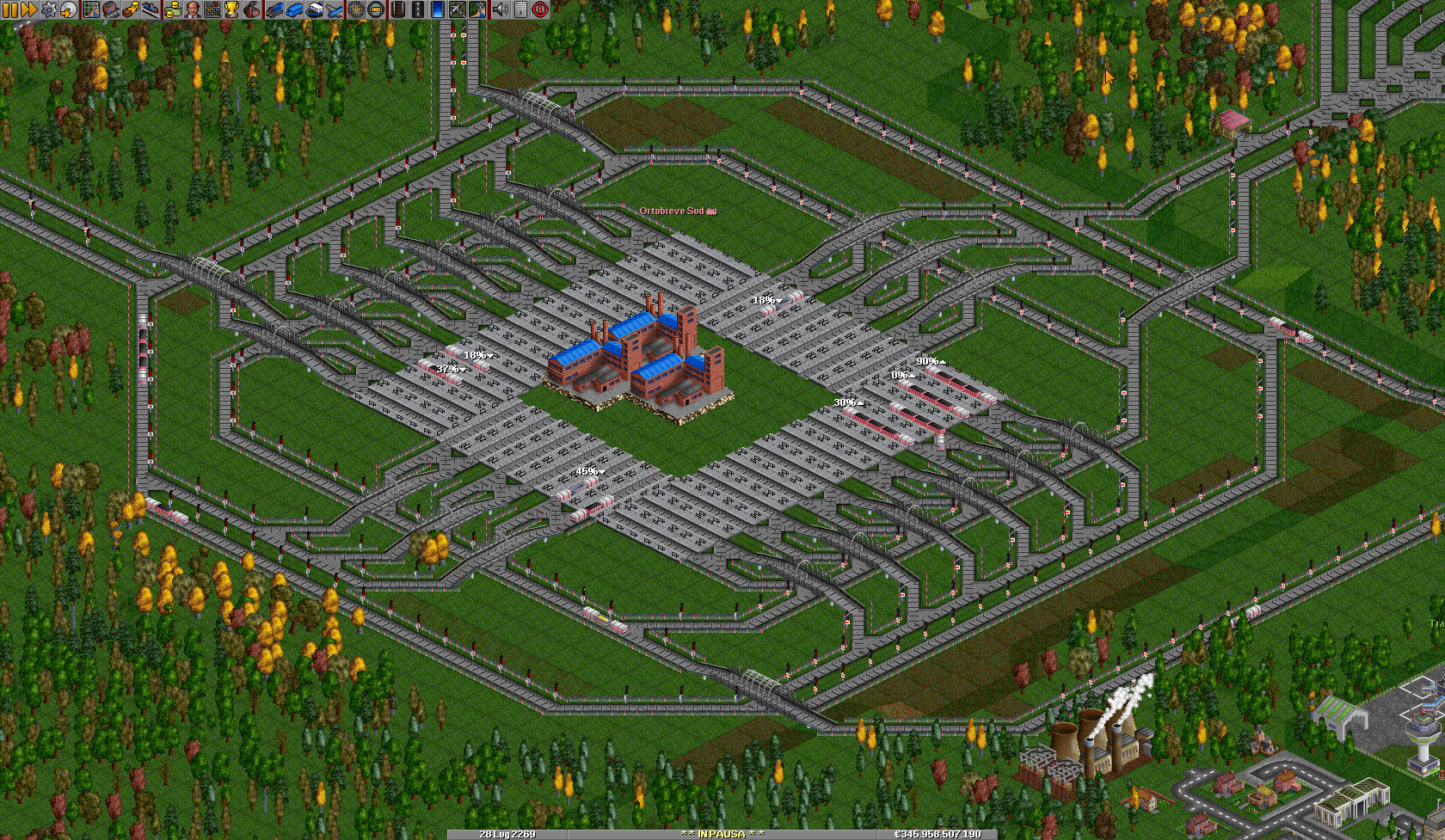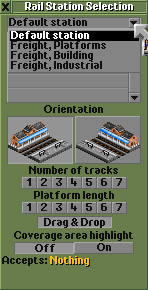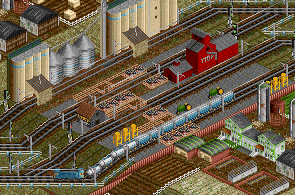- Signals · Stations · Junctions · Carrying capacity · Rail Designs & Tips
Railway Stations are the core component of any railway network. They allow any and all goods to be loaded and unloaded onto Trains. For your network, it is best to have your station off the main line so there is no unnecessary traffic passes through them causing delays for trains using the station.
Basic stations
The following stations are easy to build and will work quite decently if only being serviced by a handful of trains. When the traffic density increases, you might want to try an advanced station layout.
Terminus
These stations are the end of a railway line. Trains leave the same side they entered, and thus might block or be blocked by trains coming from or going to the station. They are often used for small and simple stations or when the available space does not permit building a ro-ro-station.
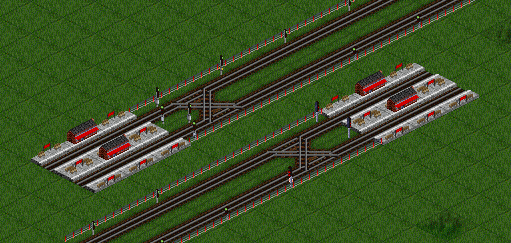
Simple terminus stations: the left one is using Pre-signals, the right one Path signals.
Ro-Ro
Ro-Ro stands for Roll-On, Roll-Off (or Roll In, Roll Out, depending who you ask) - trains enter the bottom end of station and exit the other end. Trains entering the station do not have to wait for trains leaving. This is great for medium amounts of traffic. Without Signals, it's no good for high-traffic stations (e.g., stations serving factories), because once all platforms are full, the train waits at the two way signal for the platform closest to the entrance. This can lead to gridlock if the blocking train has full load orders and is waiting for another train to drop off raw material Cargo.
Drive-thru station
A basic station which trains can either stop at or pass by. It includes waiting areas for trains departing or joining the main-line, note this is equal to the length of the station and assists in reducing or nullifying the slow-down caused by trains entering the station from the main-line as well as leaving space for trains to wait, without blocking the main-line, should all station slots in a given direction be occupied
Combined terminus- and roro-station
It is also possible to build stations which serve both as terminus and roro-stations. However, the difficulty option "Train reversing" must be set to "At end of lines and at stations" in order for them to work. Trains can enter the station from both directions, and can leave in both directions, too.
While the setup using path signals will work very well, the one using block signals will lead to trains getting stuck. This will happen if two trains coming from opposite directions pass the entry-signal almost simultaneously and want to enter the same platform. The first train will be able to enter it, while the second train will be stuck in front of a red exit-signal. Therefore you should try to avoid the block-signal setup or only use it for stations with very low traffic.
Bag station
If there is no space to build a rail from both ends of the station, but the station is not the end station, a bag station is useful too. Train will enter the station, turn around and then go out the station and continue in the original direction.
A bag station can not be built on a line with a heavy traffic because there can be only one train in each direction, and other trains have to wait before the station. This can be solved with the waiting bay, but it will not be good anymore. The trains have to slow down when entering or leaving the station too.
Advanced stations
For larger train networks, the above stations probably won't be able to handle all of the trains assigned to them. You will need more advanced track layouts and signals.
What happens when a third train arrives at one of the above stations? It sees both two-way signals are red, so it just picks the closest one and waits for the light to change. If the other platform empties while the third train is waiting, the platform will stay empty.
What about the queues that form as trains line up to enter a station? These lines can stretch far, and can even hold up your entire train network!
Pre-signals
Stations with pre-signals make arriving trains wait outside the station until there is a free platform.
Waiting bay
A good solution to hold a queue of trains waiting to enter a station is a multi-line waiting bay. If the station is full, an arriving train picks the closest empty track in the waiting bay. When a spot opens in the station, one of the waiting trains will move in. Make sure a train can fit between the signals. The pre-signals are optional; they help if your waiting bay fills up too!
Loop around
Instead of using pre-signals, you can build a loop around track. When a train enters the station and sees all the two way signals are red (platforms are full) except the loop around track, it will take the loop around track. It loops around and around, waiting for a free platform. A problem with this system is other arriving trains can steal the free platform while the first train is looping around. Remember to make the loop big enough to fit at least your longest train.
Escape depot
Another way of controlling station overflow is an "escape depot." Place a depot in the two-way/one-way signal set up at the entrance. Depots automatically have a (traditional) bi-directional signal in them so behave just like a loop around track. Escape depots, unlike loops, have an unlimited capacity.
The best layout has a depot at both ends of the station entrance. (This will reduce the time required to cross a large station)
Queue depot
With a lot of trains and central hubs (central stations which accept all resources from the whole map like: coal, steel, etc...) trains start to slows down / block each other on enter / exit station. To reduce amount of trains put them in automatic queue depot. Here are two type of queue depots exists: enter queue depot, exit queue depot.
The trick is to remove straight path rail and force train get into depot when it trying to pass trough.
Non-stop Queue depot
Queue depots has limitations - only one train can enter / exit at the same time. This technique allows you to have non-stop trains in / out into queue depot.
Long exits
Normally, when two trains leave a station at once, one must stop and give way to the other. This leaves one train half in the station and half out, making that platform unusable to any other trains trying to enter the station. Long exits allow the train to pull out of the station completely before it hits the red signal. This frees up the platform for another train entering the station. Note the length of the exit track, a 10-car train can fit neatly between the signals.
Long exits, prioritized
Getting Mammoth trains to exit a busy Ro-Ro station in a timely fashion can be challenging. By using pre-signals you can prioritize station exit tracks to allow trains on faster tracks to depart sooner. In the image below a lower priority is assigned to the topmost 5 exits (since they'll block the return track longer) and the exit at the bottom (since trains accelerate slower on the sharp bend) by requiring them to wait upon the block exit pre-signal. They must wait for the exit signal to clear (that is, when a train passes the 2nd signal on the return track). The other tracks are not forced to do so and will depart when a train passes the 1st signal as usual.
Long entrances
If you play with Realistic acceleration, faster trains slow down a good bit before stopping in a station. This can delay the next train from entering. Adding a few track sections in front of the station can help with this.
Double entrance
This is a type of design used for stations that handle a huge number of trains, such as the stations servicing factories or food processing plants. Trains coming from one place can use loading bays meant for other trains if need be. Be sure to use pre-signals.
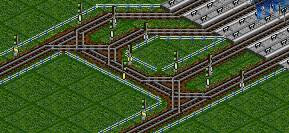
Double entrance. Those 4 platforms are divided into 2 groups with each handling 1 entry track. The combo-signal inbetween the junctions allows the trains from both entries entering the platforms simultaneously without interfering each other, but reserving the way for trains to cross-over to the other group when no platform is available on its group.
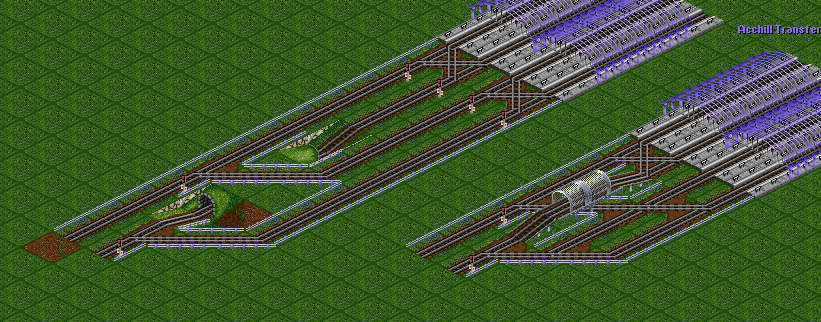
You can also use path based signals. The top one allows the train to wait within the design, but trains can get stuck on one side if the other opens up, similar to when block signals are used when pre-signals are needed. For the bottom one, there is no reason to make it as long as your trains are, as they will wait at the PBS anyways. The design has been tweaked slightly to eliminate some sharp turns, so it's friendly to long trains, and is a great compromise between speed and size. It's also friendly with realistic acceleration; the area after the PBS acts as breaking space.
Feeder bays
If your rail network has large trains going long distances, it can be very cost effective to "feed" their loading station with more cargo from nearby industries. Because the longer the distance the cargo travels, the more you get paid. In the pictured station, there are 4 bays for small trains to transfer coal from nearby mines. Large trains then deliver the coal to a far away power station.
Prioritised drive-thru stations
These stations are in the middle of a line and trains can pass them by without using up valuable platforms. Signalling makes a crucial difference here - you can give priority to the mainline trains or the stopping trains with them.
This station gives priority to trains leaving the station.
This station gives priority to trains passing the station by.
Ro-Ro Terminus
Principle
This style of station is a mix between the Ro-Ro and Terminus styles. In essence, it takes a terminus station and makes it possible for a train to leave its platform without disrupting the traffic flow entering the station. It can be used to upgrade a terminus style station and improve station efficiency. Modifications upon this design could increase the number of platforms to handle a larger number of trains at once. The example has been pre-signaled for greater efficiency.
This build allows trains to enter and exit station simultaneously. However, it takes a bit more space than ordinary terminus.
Variations
Giant Ro-Ro terminus
It's of course possible to increase the number of platforms of a Ro-Ro terminus station. You can go as far as you want as long as there's enough space.
Below is a little more efficient design, with two tracks each sharing an entry and exit line. It consumes half as much space while nearly not decreasing the capacity. It is important that the directions are not switched: Else trains would have to climb up when entering the track, blocking the crossing unneccessarily long.
Here bridges instead of tunnels
Here is another high throughput Ro-ro station. The bridges are low quality concrete only to make them stand out visually. The left side uses bridges (obviously) and path based signaling. The right side uses tunnels and pre-signals.
This station continues on that design, but with separate two pairs of separate entry/exit tracks.
An even higher capacity Ro-Ro Terminus mix
This is a huge Ro-Ro terminus for very busy lines. There are 2 tracks inbound, 2 tracks outbound and 4 train can enter and exit at the same time (2 enter and 2 exit).
Advanced Combined Terminus- and Roro-Station
As with a standard ro-ro station, trains enter at one end of station and exit on the other end, thus trains entering the station do not have to wait for trains leaving. This station is designed so that non-stop trains can pass through the station without unnecessarily blocking empty platforms from trains that need to stop at the station. It can serve as a terminus station without the need to reverse train direction. It includes escape depots so it can endure heavy traffic even if there is no space to add additional platforms. This station design is an efficient trade-off between the fast advanced terminus types and saving precious building space.
Roundabout station
Can handle a huge amount of small trains.
NewGRF Stations
NewGRF Stations, or newstations, are available after you have activated a Newstations grf file. You will then have access to a new station-building GUI.
The new GUI has a drop down box of station groups. Each group has a number of station tiles to choose from. Select a station tile and it will be previewed in the orientation boxes. Some newstation tiles do not allow trains to enter for the effect of full buildings or buffer stops. Be aware when placing newstation tiles that some tiles do not allow more than so many tracks or squares. The numbers not allowed will be greyed out and you cannot build this size. Some newstations sets offer more visual effects than others. For example, in Michael Blunck's newstations, passengers will gather on station platforms as the waiting cargo increases.
If the station set contains newgrf waypoints, the Waypoint GUI will open upon selecting it. You will have full previews of every waypoint possible for you to build. Most waypoints have introduction and obsoletion dates, in which waypoint styles will be replaced by newer versions. However, any waypoints you have already built will not automatically changed, allowing for variation on your networks.
Newstations behave the same as normal stations; the only difference is the non-track tiles that block trains.
















